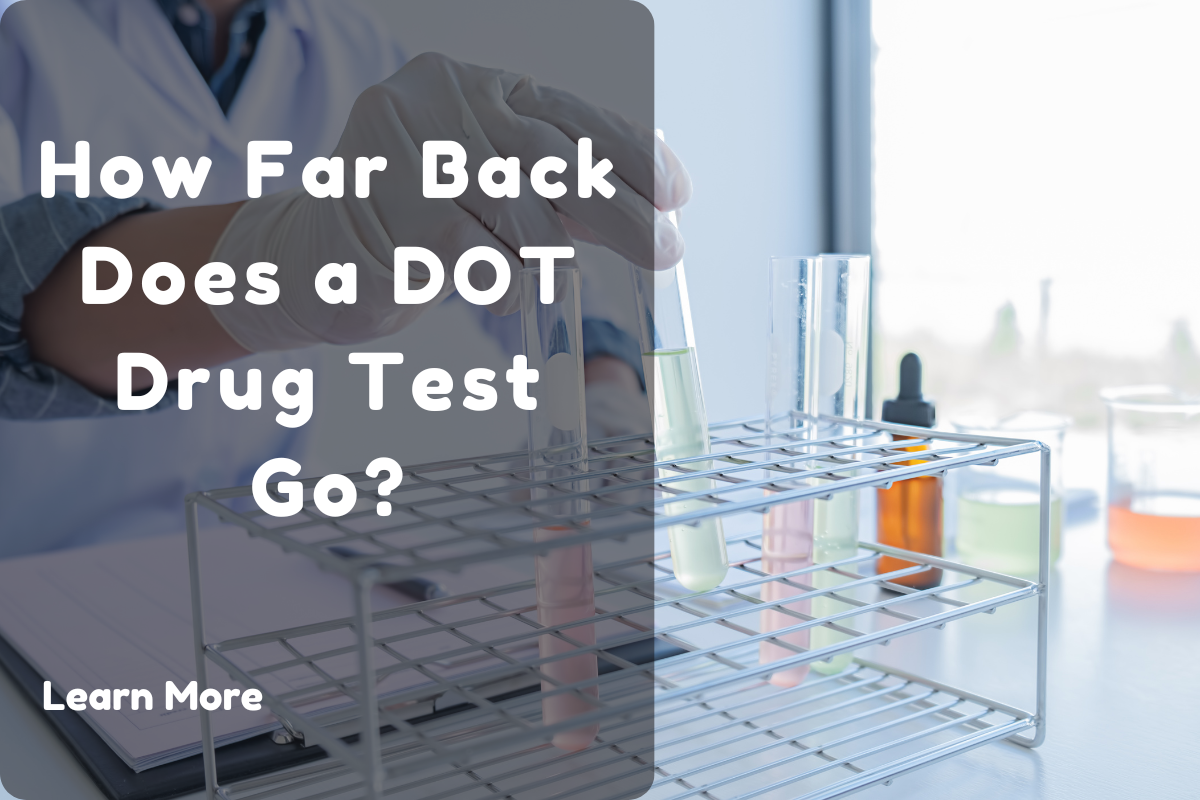Introduction to DOT Drug Testing and Its Duration
Drug testing for commercial drivers under the Department of Transportation (DOT) regulations is a critical safety measure aimed at ensuring that drivers are fit to operate large vehicles. These tests are designed to detect the use of illicit substances and ensure that commercial drivers adhere to strict health and safety guidelines. As part of the effort to maintain road safety, DOT drug testing is mandatory for anyone who holds a Commercial Driver’s License (CDL) and drives a vehicle that meets certain weight and transportation criteria.
The primary goal of DOT drug testing is to prevent accidents caused by impaired driving. Given the high risks associated with operating large trucks and buses, commercial drivers are subject to more stringent drug testing standards than other workers in the country. The tests are meant to catch drivers under the influence of drugs that can impair their judgment, reflexes, and overall ability to drive safely.
Purpose of DOT Drug Testing
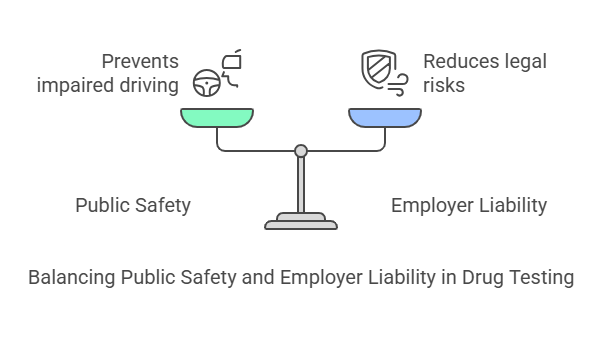
Drug testing for commercial drivers is necessary for several reasons. First and foremost, it ensures public safety by preventing impaired drivers from getting behind the wheel of large vehicles that can pose significant hazards to themselves and others on the road. By maintaining a drug-free workforce, the DOT aims to reduce the number of accidents related to substance abuse and to promote responsible driving behaviors.
For employers, adhering to DOT drug testing regulations helps mitigate liability. By ensuring that drivers are drug-free, companies reduce the risk of being held accountable for accidents caused by impaired drivers. Moreover, drug testing also helps employers comply with federal regulations, which could otherwise result in fines, penalties, or even a loss of authorization to operate certain commercial vehicles.
How Far Back Does a DOT Drug Test Go?
When it comes to DOT drug testing, the question of “how far back” the test can go is an important one. This refers to the time period for which a driver’s drug use history is considered. While the DOT drug test itself typically tests for recent drug use (from a few hours to a few days, depending on the substance), the employer also considers the driver’s previous drug testing history as part of the pre-employment screening and random selection process.
In practice, the duration of time that a DOT drug test can go back varies depending on the context:
- Pre-employment testing: When hiring a new driver, employers are required to check the driver’s previous drug test history for up to three years. The driver must provide consent for the employer to obtain these records, which helps the employer ensure that the driver has not violated any previous drug testing policies.
- Random and Post-Accident Testing: For random and post-accident drug tests, the focus is on recent drug use. These tests are meant to detect drugs within a short time period before the test is administered. Drugs can be detected in urine, saliva, blood, and hair, and the length of time they stay in the system depends on the substance itself. For example, marijuana can be detected in a urine test for up to 30 days, while cocaine may only stay in the system for a few days.
- Drug Use History Review: The DOT requires employers to review a driver’s drug and alcohol use history before they are allowed to hire them. This review period typically goes back three years to ensure that the potential employee has not violated any drug use policies during that time.
- Record Retention: According to DOT regulations, employers are required to keep records of drug testing for a certain period of time. These records must be kept for at least five years for positive test results or refusal to take a test, and one year for negative test results or completed return-to-duty documentation.
Common Substances Tested for in DOT Drug Tests
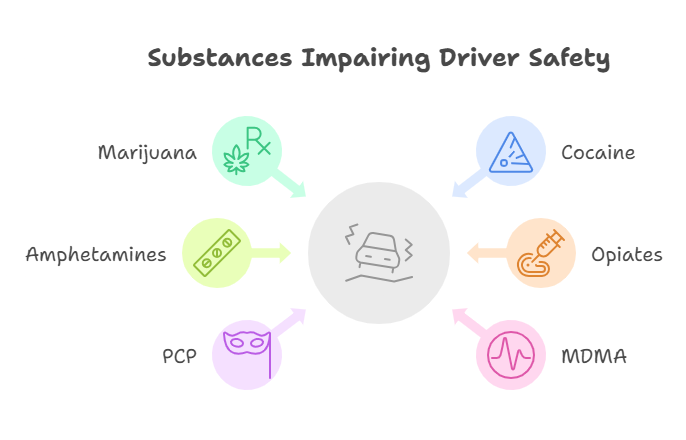
The DOT drug testing panel is designed to detect substances that are commonly abused and that could impair a driver’s ability to operate a vehicle safely. The substances included in the standard DOT drug test are:
- Marijuana: Despite the legalization of marijuana in some states, it remains illegal under federal law, and its use can impair a driver’s ability to perform essential driving tasks. The DOT tests for THC (tetrahydrocannabinol), the active ingredient in marijuana.
- Cocaine: Cocaine is a powerful stimulant that can have severe effects on a driver’s ability to focus and react to situations quickly. It can be detected in the system for up to 2-4 days.
- Amphetamines: This class of drugs includes substances like methamphetamine, ecstasy, and prescription stimulants. These drugs can significantly impair a driver’s cognitive functions, including attention and reaction time.
- Opiates: Drugs such as heroin, codeine, and morphine are classified as opiates and can significantly impair motor skills and decision-making. These drugs can be detected for several days after use.
- Phencyclidine (PCP): PCP is a dissociative drug that can cause extreme behavior changes, such as agitation and hallucinations. It is also tested for under DOT regulations.
- MDMA (Ecstasy): Although less commonly abused, MDMA is a drug that can cause a range of impairments, including delayed reaction times and increased risk-taking behavior.
Statistics and Importance of DOT Drug Testing
The statistics surrounding drug-related accidents in the commercial transportation industry highlight the importance of DOT drug testing. According to the National Highway Traffic Safety Administration (NHTSA), impaired driving is one of the leading causes of accidents, injuries, and fatalities on the road. In the U.S., nearly 29% of fatal accidents involve drivers who are under the influence of drugs or alcohol. By implementing strict drug testing requirements, the DOT aims to reduce the number of accidents caused by impaired commercial drivers.
Moreover, DOT drug testing is essential for employers in the trucking industry to comply with federal regulations and avoid penalties. Non-compliance with DOT drug testing requirements can result in significant fines and legal consequences. Additionally, employers are at risk of facing reputational damage if they fail to enforce drug-free workplace policies effectively.
The Process, Compliance, and Challenges of DOT Drug Testing
DOT drug testing involves a well-defined process, both from the driver’s perspective and the employer’s responsibilities. Understanding the entire procedure is crucial for ensuring compliance with regulations and maintaining a drug-free workforce. This section will break down the process involved, the challenges that employers and drivers might face, and the compliance requirements that must be adhered to.
The Steps Involved in a DOT Drug Test

The process of a DOT drug test typically follows a series of steps to ensure accuracy and fairness. Below is an overview of the steps involved, from notification to testing and reporting:
- Notification of the Test: The first step in a DOT drug test is the notification. If a commercial driver is selected for a random drug test, the employer must inform the driver as soon as possible. Typically, drivers are informed on the day of the test or shortly before testing takes place, especially in cases of random or post-accident tests.
- Testing Facility: Once the driver is notified, they are required to go to an approved collection site. This could be a medical facility, clinic, or another designated location. The test will be administered under supervision to ensure that the driver does not tamper with the sample. For urine tests, the driver will be asked to provide a sample, which is then sealed and labeled for analysis.
- Drug Test Administration: The most common form of DOT drug testing is the urine drug test, although other methods such as saliva, blood, and hair testing may be used. The urine drug test typically checks for the following substances: marijuana, cocaine, amphetamines, opiates, PCP, and MDMA. Depending on the test type, drug levels are measured in the sample provided. After the sample is collected, it is sent to a certified laboratory for analysis.
- Laboratory Analysis: The laboratory will analyze the sample to detect any drugs present in the system. There are specific cutoff levels for each drug, and only substances that exceed these thresholds are considered positive results. The laboratory will provide the results to a Medical Review Officer (MRO), who will review the findings to determine if any medications or other factors could explain the results.
- Result Reporting: Once the MRO has reviewed the results, they are reported back to the employer. If a driver’s drug test is positive, they are prohibited from performing safety-sensitive functions until they have completed a return-to-duty process and been cleared by a substance abuse professional (SAP). If the test is negative, the driver can resume their duties without restrictions.
Compliance Requirements for Employers and Drivers
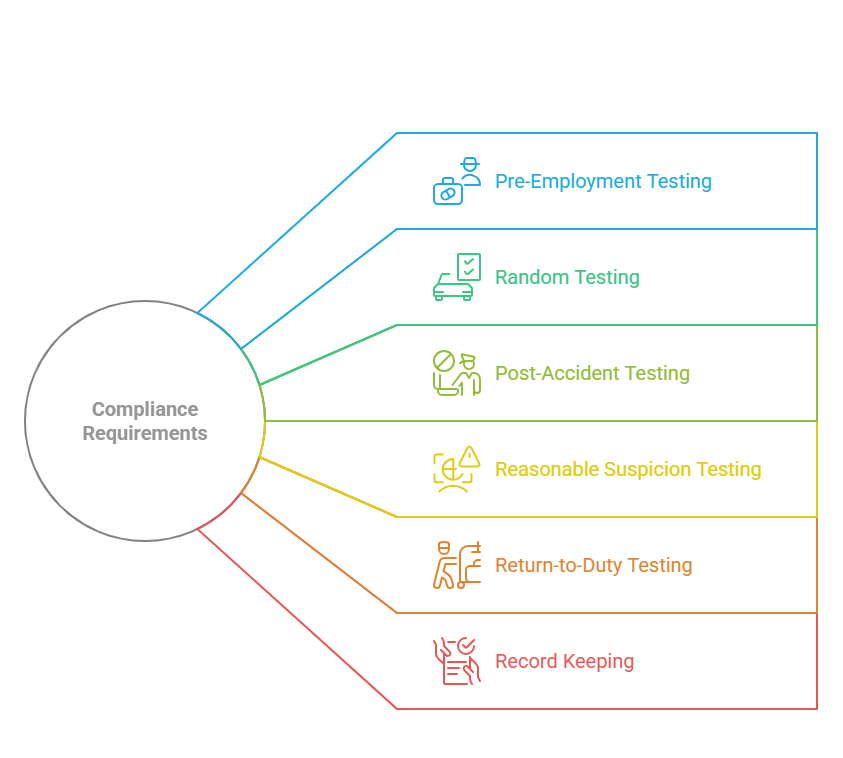
Employers are responsible for ensuring that their drivers comply with DOT drug testing regulations. Compliance includes conducting the required tests, keeping accurate records, and adhering to reporting requirements. Here are the primary compliance obligations for employers:
- Pre-Employment Testing: Before hiring a new driver, employers must conduct a pre-employment drug test. This is a one-time test that ensures the driver does not have a history of substance abuse before entering the workforce. Employers must also check the driver’s drug testing history over the previous three years to verify compliance with DOT regulations.
- Random Testing: Employers are required to implement a random testing program that selects drivers for drug testing throughout the year. The testing is random and unannounced, which helps deter drivers from using drugs or alcohol. Employers must conduct random drug tests at a rate determined by the DOT (which is typically at least 50% of the driving workforce annually).
- Post-Accident Testing: If a driver is involved in an accident that results in significant property damage or injury, they must undergo a drug test as soon as possible. This test determines whether drugs or alcohol were a contributing factor to the accident. The test should be conducted within 8 hours of an accident for alcohol and 32 hours for drug testing.
- Reasonable Suspicion Testing: If an employer has reason to believe that a driver may be under the influence of drugs or alcohol, they must conduct a drug test based on reasonable suspicion. This could be based on observed behavior, erratic driving, or other signs of impairment.
- Return-to-Duty Testing: If a driver tests positive or refuses to take a drug test, they must complete a return-to-duty program. This program typically involves counseling, treatment, and follow-up testing to ensure the driver is no longer using drugs or alcohol. Return-to-duty testing is required before the driver can return to safety-sensitive duties.
- Record Keeping: Employers must maintain records of all drug tests for a specified period of time. This includes results, notifications, and other relevant documentation. According to DOT regulations, employers must keep records of positive test results for a minimum of 5 years and negative test results for 1 year. This helps ensure compliance and provide evidence in case of audits or legal challenges.
Common Misconceptions About DOT Drug Testing Duration
A common misconception about DOT drug testing is that it can detect drug use from years ago. In reality, the drug testing process does not involve reviewing long-term drug use history, but rather focuses on recent use and past test results. The DOT drug test typically measures recent drug use, with substances staying in a driver’s system for a short period (days to weeks, depending on the substance). However, past drug test records—such as those from pre-employment or previous tests—are retained by employers and could be reviewed during hiring or compliance checks.
Preparing for the Transition: How Companies Can Adapt

With the growing complexity of DOT drug testing regulations, employers must ensure their companies are prepared for changes and compliance requirements. Here are some key steps employers can take:
- Training and Education: Employers should provide training for supervisors and managers about how to identify signs of impairment and understand the drug testing requirements. This ensures that they can make informed decisions regarding reasonable suspicion testing.
- Update Policies: Employers need to update their drug-free workplace policies to reflect the latest DOT regulations and ensure that all employees are aware of the testing protocols and their rights.
- Use Reliable Testing Services: Employers should work with a reputable service provider to manage their drug testing programs. A service provider can handle everything from testing administration to result reporting, ensuring that all regulatory requirements are met.
- Monitor Compliance: It’s essential for employers to regularly monitor their compliance with DOT regulations. This involves tracking when tests are due, maintaining accurate records, and ensuring that all drivers receive the required testing.
RapidHireSolutions and DOT Drug Testing Services
At RapidHireSolutions, we specialize in DOT drug testing and employment screening services for trucking companies and other commercial employers. Our services are designed to help employers stay compliant with the DOT’s drug testing regulations and to ensure a safe, drug-free workforce.
We offer:
- Pre-employment drug tests
- Random drug testing programs
- Post-accident testing
- Reasonable suspicion testing
- Return-to-duty testing
Our team helps you navigate the complexities of DOT regulations, ensuring that your company remains compliant with the required drug testing standards. Additionally, we provide access to a secure portal for test results, making it easy to manage and track testing records.
Table Comparison: Below is a table that compares DOT drug testing timelines with other types of drug tests:
| Test Type | Tested Period | Frequency | Example Substance |
|---|---|---|---|
| Pre-Employment | Previous 3 years | One-time | Marijuana, Cocaine, Amphetamines, etc. |
| Random Testing | Recent drug use (days/weeks) | Throughout the year | Any substance on the DOT panel |
| Post-Accident | Recent use (hours/days) | As needed after accidents | Any substance on the DOT panel |
| Reasonable Suspicion | Recent drug use (hours/days) | As needed based on suspicion | Any substance on the DOT panel |
| Return-to-Duty | Recent drug use (days/weeks) | As needed after a violation | Any substance on the DOT panel |
Legal Aspects, FAQs, and Conclusion: DOT Drug Testing
The legal landscape surrounding DOT drug testing is complex, as it incorporates federal, state, and industry-specific regulations. Employers must navigate these legalities carefully to maintain compliance, protect the privacy of their employees, and ensure a safe work environment. In this section, we will explore the legal aspects of DOT drug testing, including retention requirements and privacy concerns, and answer frequently asked questions (FAQs) to provide clarity on common misunderstandings. Finally, we will summarize the key takeaways regarding DOT drug testing and its role in maintaining safety and compliance.
Legal Aspects of DOT Drug Testing
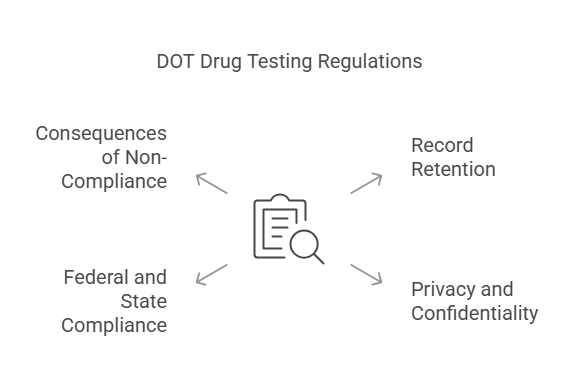
DOT drug testing regulations are mandated by the Federal Motor Carrier Safety Administration (FMCSA), which is part of the U.S. Department of Transportation. The purpose of these regulations is to reduce accidents and fatalities involving commercial drivers under the influence of drugs or alcohol. Here are the primary legal aspects of DOT drug testing:
- Retention of Records: According to DOT regulations, employers are required to retain records of drug tests for a specific period. The retention period varies depending on the outcome of the test:
- Positive test results must be retained for 5 years.
- Negative test results must be kept for 1 year.
- Drug test refusals must be retained for 5 years.
These records must be made available to the FMCSA or other regulatory agencies upon request. Proper record-keeping ensures that employers are compliant with DOT regulations and can verify the testing history of drivers, especially during audits or legal proceedings.
- Privacy and Confidentiality: Privacy concerns are a critical issue in DOT drug testing. The results of a drug test must remain confidential and can only be shared with certain individuals, such as the driver, the employer, and the Medical Review Officer (MRO). The driver’s personal information, including the results of the drug test, cannot be disclosed to third parties without explicit consent from the driver, except in situations where the law requires it.
- Employers must ensure that drug testing procedures are conducted in a manner that protects the privacy of the driver, ensuring that the collection process is done with respect and confidentiality.
- The chain of custody must be maintained for drug samples. This involves ensuring that the sample is properly sealed, labeled, and transported to a certified laboratory without any tampering. Failure to maintain this chain can result in invalid test results.
- Compliance with Federal and State Laws: DOT drug testing is governed by federal law, but employers must also be mindful of state laws that might affect how drug testing is conducted. Some states have legalized recreational marijuana use, but marijuana remains illegal under federal law. This creates potential conflicts between state and federal regulations for employers who operate across state lines.
- Employers must comply with federal regulations, even in states where marijuana use is legal. As a result, a driver may test positive for marijuana on a DOT test even if they are in a state where it is legal for recreational use.
- States may also have additional requirements for workplace drug testing, which may affect how the DOT testing regulations are applied. Employers should work with legal counsel to ensure they comply with both state and federal laws.
- Consequences of Non-Compliance: Non-compliance with DOT drug testing regulations can lead to severe consequences for both the employer and the driver:
- For employers: Failing to adhere to the DOT’s drug testing requirements can result in penalties, fines, and even the suspension of the employer’s ability to operate commercial vehicles. The FMCSA may impose financial penalties, and repeated violations can lead to the revocation of the employer’s operating authority.
- For drivers: A positive drug test result or a refusal to take the test can lead to serious consequences for the driver, including the loss of their commercial driver’s license (CDL). The driver may be prohibited from performing safety-sensitive functions until they complete a substance abuse program and return-to-duty process.
For both employers and drivers, non-compliance can have long-lasting effects on careers and business operations, making it essential to adhere to the regulations set forth by the DOT.
Frequently Asked Questions (FAQs) about DOT Drug Testing
How far back does a DOT drug test go?
A DOT drug test checks for substances that are currently present in a driver’s system. The drug testing process does not involve looking at a driver’s entire history of drug use but rather focuses on recent use (usually within a period of days or weeks, depending on the substance). However, drug test history records are retained for a period of time by employers and can be checked during background screenings, especially during pre-employment testing.
What substances are tested for in a DOT drug test?
DOT drug tests screen for the following substances:
- Marijuana
- Cocaine
- Amphetamines
- Opiates
- Phencyclidine (PCP)
- MDMA (Ecstasy)
These are the standard substances tested for under the FMCSA’s guidelines. Additional testing for alcohol may also be required under certain circumstances (e.g., post-accident or reasonable suspicion testing).
What happens if a driver tests positive on a DOT drug test?
If a driver tests positive on a DOT drug test, they are immediately removed from safety-sensitive duties, such as driving a commercial vehicle. The driver is required to complete a return-to-duty process, which typically includes counseling, treatment, and follow-up testing. The driver must be cleared by a substance abuse professional (SAP) before they can return to their duties.
Can a driver refuse a DOT drug test?
A driver can refuse to take a DOT drug test, but this is treated as a positive result. A refusal is considered a violation of DOT regulations and results in the driver being removed from safety-sensitive duties. A refusal to test can lead to the same consequences as a positive test, including the requirement to undergo a return-to-duty process.
How often do DOT drug tests occur?
DOT drug tests are conducted in several circumstances:
- Pre-employment testing for new hires
- Random testing throughout the year
- Post-accident testing if the driver is involved in an accident
- Reasonable suspicion testing if the employer suspects drug use
- Return-to-duty testing after a positive test or refusal
The frequency of these tests varies, but employers are required to ensure that their drivers are subject to random drug testing at least 50% of the driving workforce each year, as mandated by the FMCSA.
Conclusion
DOT drug testing is an essential component of ensuring safety on the nation’s roadways. The regulations set forth by the FMCSA aim to keep commercial drivers free from drug use and prevent accidents caused by impaired driving. Employers and drivers must understand the legal and compliance aspects of DOT drug testing to maintain a safe and compliant workforce.
The key takeaways are:
- DOT drug testing is required for all commercial drivers and includes pre-employment, random, post-accident, reasonable suspicion, and return-to-duty tests.
- Employers must adhere to strict record-keeping regulations and ensure that drug tests are administered in accordance with federal guidelines.
- Privacy is a significant concern in DOT drug testing, and employers must maintain confidentiality and follow proper procedures to protect drivers’ rights.
- Non-compliance with DOT drug testing regulations can result in serious legal and financial consequences for both employers and drivers.
By staying informed about the requirements and processes involved in DOT drug testing, employers and drivers can help create a safer environment on the road and protect themselves from the consequences of non-compliance.

